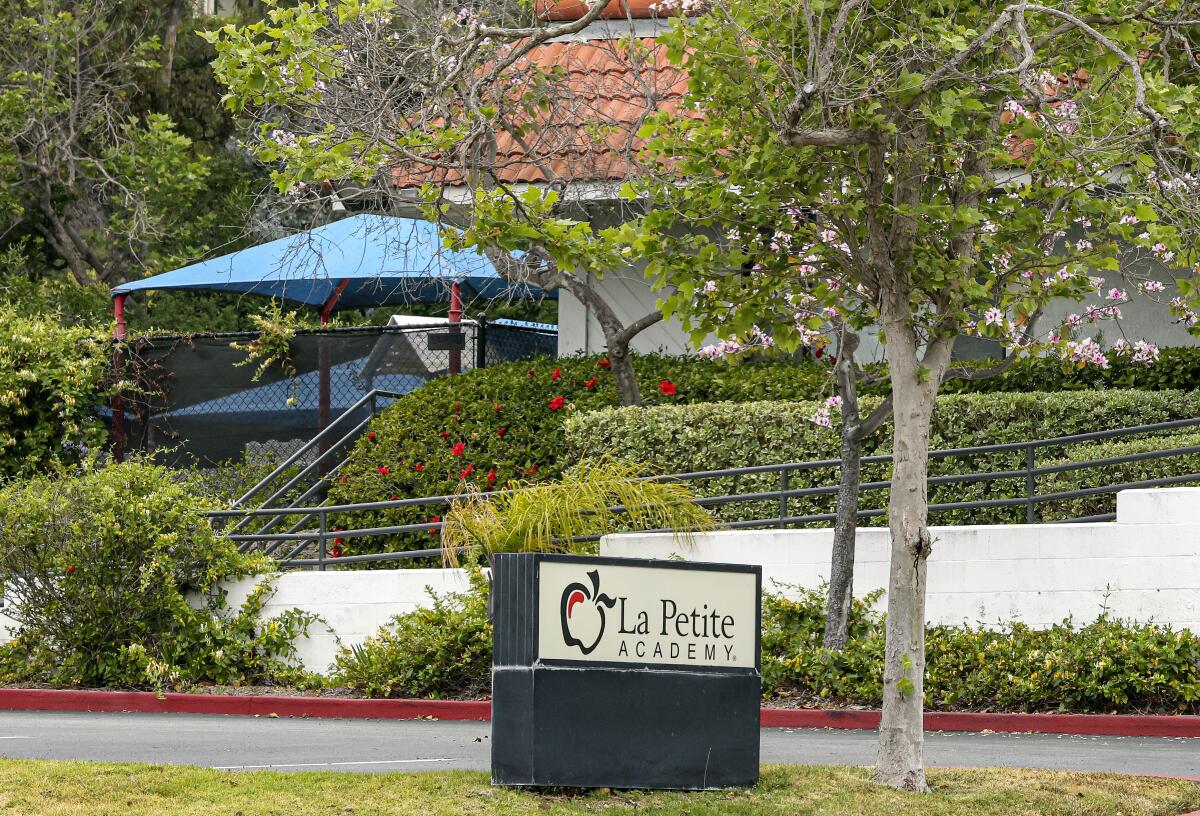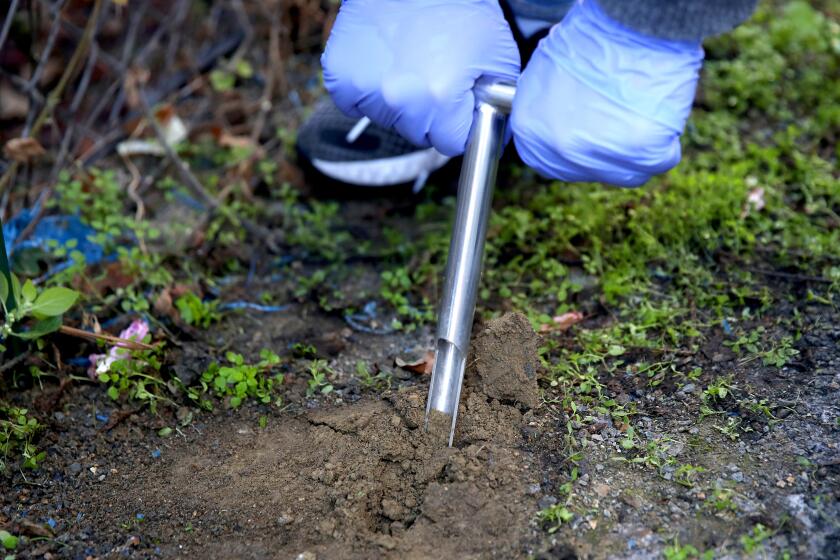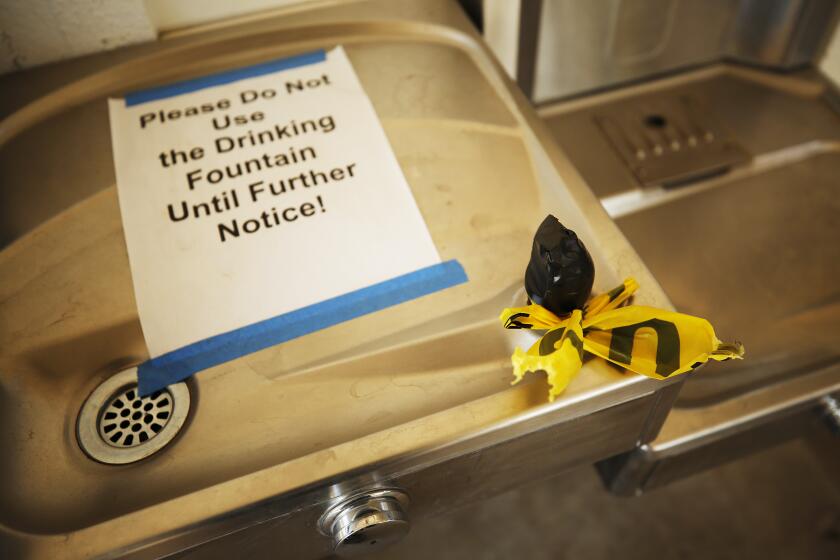Drinking water at 1 in 4 California child-care centers tests dangerously high for lead

In test results that suggest thousands of California infants, toddlers and children continue to be exposed to brain-damaging lead, data released by the state Department of Social Services has revealed that 1 in 4 of the state’s child-care centers has dangerously high levels of the metal in their drinking water.
Lead, a potent neurotoxin that poses a particularly grave threat to children, was discovered in the water systems of nearly 1,700 child-care centers licensed by the state. The highest results came from a facility in San Diego that recorded 11,300 parts per billion at the time of testing — well above the state’s limit of 5 ppb in child-care centers. One ppb is the equivalent of one drop of contaminant in 500 barrels of water.
“These findings show that California children who are spending the majority of their hours in licensed care are consuming water that has very high levels of lead, and this is very concerning,” said Susan Little, senior advocate for California government affairs for the nonprofit Environmental Working Group.
Numerous homes that underwent remediation have been left with lead concentrations in excess of state health standards, according to USC researchers.
For the record:
8:21 a.m. May 18, 2023An earlier version of this story stated that some 1,690 locations tested below the state’s threshold of 5 ppb. They tested above.
The results mark the first time in state history that child-care facilities have been required to test for lead. Of the 6,866 facilities whose test results have been disclosed, eight sites exceeded the 5-ppb limit by 200 times, 76 surpassed it by 20 times, and 183 by 10 times. Some 1,690 locations tested above the state’s threshold of 5 ppb.
Experts say that even at low levels, lead can lower a child’s IQ, impair their development and hearing, contribute to learning and behavior problems, and damage their brains and nervous systems. Lead in drinking water cannot be seen or tasted.
“Not only are we seeing very clear evidence that there is a problem in our child-care centers and in different care settings, but that this is really the tip of the iceberg,” Little said. “Parents and decision makers really need to pay attention to these findings, and we need to step up and try to make sure the water children are drinking at these centers and elsewhere is free of lead.”
Several child-care centers that were contacted by The Times said the test results came from faucets or fountains that had been out of use for a long time and that children were not drinking the water. They said the contamination was caused by lead leaching from older pipes and plumbing fixtures. In an email, the California Department of Social Services said that under the law, facilities “must immediately make inoperable and cease using the fountain(s) or faucet(s) where elevated lead levels exist,” and that they would work with centers on a plan for correction.
Assembly Bill 2370, authored by Assemblymember Chris Holden (D-Pasadena) and sponsored by the Environmental Working Group, was passed in 2018 and requires licensed child-care centers built before 2010 to test for lead in drinking water every five years. Facilities that exceed acceptable limits must reduce their lead levels, distribute educational materials to parents, and provide health and safety training for child-care providers. This is the first round of testing since the law was implemented.
“[These] are numbers that we were hoping we would not see,” Holden said. “I think we were obviously hoping and believing that these pipes were in better shape — we know that there would be some level of leaching because of the age of the systems, but to have them as high as they were, it went from a blinking yellow light to a flashing red light.”
A drinking water source at La Petite Academy in San Diego — the site with the highest lead levels — had 2,200 times the allowable concentration for child-care centers. The second- and third-highest levels were found in Los Angeles County: Van Wig Head Start & State Preschool in La Puente tested at 4,700 ppb, while Happy Campers Children’s Center in Baldwin Park tested at 3,800 ppb.
Children in many California schools may to exposed to lead in water fountains unless school districts conduct widespread testing and, if needed, clean up.
Learning Care Group, the parent organization of La Petite Academy, said in a prepared statement that the highest lead results were from drinking water fountains that had not been used since before the pandemic, but were “immediately removed from the building” after testing.
The organization said it has conducted other remediation efforts, such as replacing faucets and supply lines, eliminating lead buildup and installing filters where appropriate. Following remediation and retesting on Nov. 23, 2022, all outlets at La Petite Academy in San Diego were in compliance, the organization said.
“According to our vendors, high lead levels can result from a variety of factors, including materials found in the manufacturing of common faucets as well as buildup from lack of use,” the organization added. “This was not the result of a larger concern.”
At La Puente’s Van Wig Head Start & State Preschool, “the fixtures that came out with high contents were fixtures that were not being used,” said Rosie Ducoing, child development program director for Bassett Unified School District, which runs the center. A third-party vendor flushed and cleaned the sites with elevated lead levels as part of its remediation, she added. The facility is awaiting results of retesting conducted in April.
Doug Rimerman, development director for Life Steps Foundation, the parent organization of Happy Campers Children’s Center in Baldwin Park, said the facility has a policy “requiring parents to provide drinking water for their children to bring with them to the center.” He said the three water outlets that exceeded the lead threshold had not been used for many years and remain covered to prevent use.
“We are preparing to have them replaced and retested at a future date,” he said.
According to the American Academy of Pediatrics, “there is no safe level of lead exposure in children.” Kids with levels as low as 5 micrograms per deciliter of lead in their blood can have permanent cognitive impairment. At that level, the Center for Disease Control and Prevention suggests evaluation and intervention.
The more stringent standard announced by the Centers for Disease Control and Prevention will more than double the number of kids with worrisome levels of the toxic metal in their blood.
While most children with elevated lead levels are asymptomatic, they may complain of headaches, stomach pain, constipation or loss of appetite, so blood testing is the best way to determine if a child has been exposed to or has lead poisoning, experts say. Drowsiness and clumsiness, agitation or decreased activity may indicate impacts to the central nervous system and may be followed by vomiting, unresponsiveness and convulsions. Damage from lead poisoning is irreversible.
The most common sources of lead in drinking water are lead fixtures, faucets and pipes, which are more likely to be found in older cities and homes built before 1986, according to the Environmental Protection Agency. Lead can also enter drinking water when plumbing materials that contain the metal corrode.
Also, many of the facilities with alarming amounts of lead are in low-income areas or communities of color, Holden said, suggesting the problem is borne unequally. “And then the question is: Why are some of these students having such a hard time learning? There could be a direct correlation there that obviously could be impactful to their education, health and safety,” he said.
Lead in drinking water is not just a problem of child-care centers, however.
A recent nationwide report found that 53% of school districts in California had lead in their water at one or more taps as of March 2020.
The Get the Lead Out assessment by the California Public Interest Research Group gave the state a “C” grade this year for its “middling” policies to protect kids from lead-contaminated drinking water at schools.
And although a 2017 law required schools built before 2010 to test their water sources for lead, it didn’t require them to test all faucets and required remediation only if the water contained more than the federal standard of 15 parts per billion, an amount health experts have long said is unsafe. The most recently reported data conducted in compliance with that law revealed that more than 2,100 school drinking water fountains in California tested positive for lead across 1,300 schools.
Assemblymember Holden is also trying to change that.
If passed, AB 249 would require that water fountains and faucets at public and private schools built before 2010 be tested every five years and cleaned up if polluted with lead. The nonprofits Environmental Working Group and Children Now are sponsoring the legislation.
More to Read
Sign up for Essential California
The most important California stories and recommendations in your inbox every morning.
You may occasionally receive promotional content from the Los Angeles Times.














